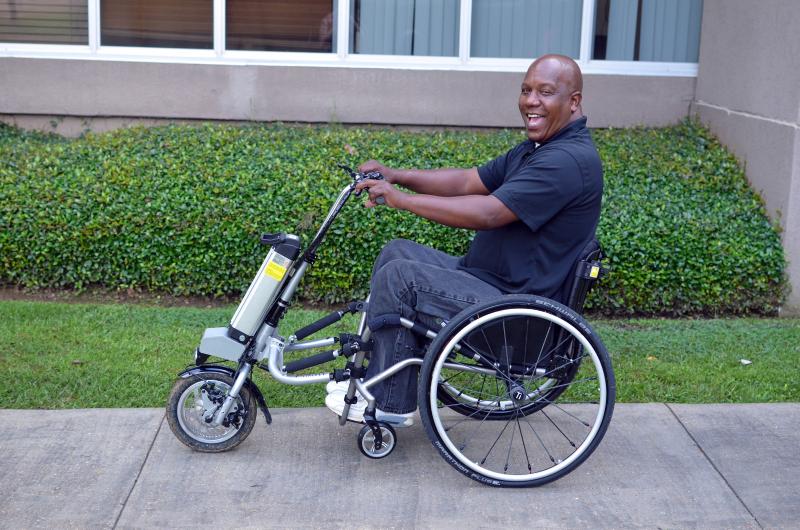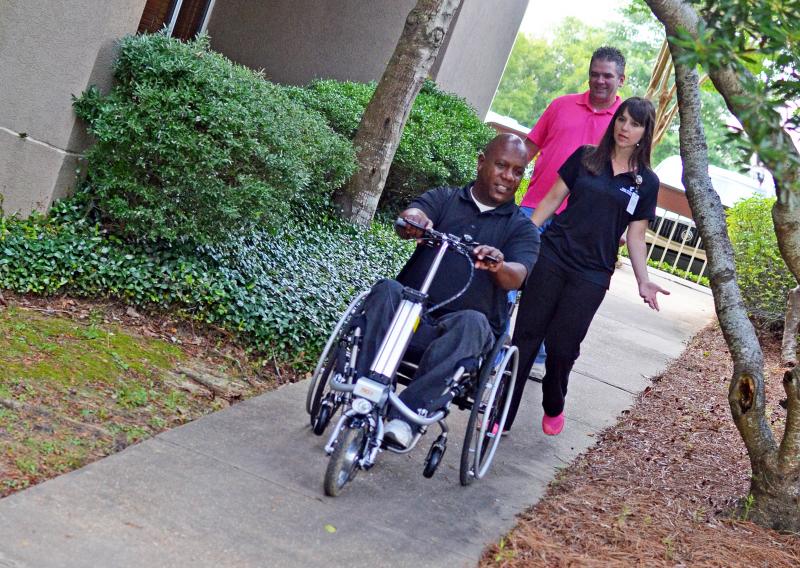Adrian Benson’s new ride recently caused some rubber-necking as he whizzed through the parking lot of Methodist Rehabilitation Center’s Assistive Technology Clinic in Flowood.
People don’t expect a wheelchair to have a chopper-style front fork or reach speeds of 12 miles per hour.
But the innovative design suits Benson’s active lifestyle.
“This is what’s up,” said the 40-year-old Canton resident, who became a paraplegic in a 2003 car wreck. “It definitely beats a power wheelchair any day. It’s super convenient.”
Equipped with shiny handlebars, a twist-grip throttle and two brake levers, the Rio Mobility Firefly is a hand cycle that turns standard manual wheelchairs into motorized trikes.
But it wasn’t the coolness quotient that sold Benson on the device.
After a dozen years pushing a wheelchair, he wanted a system to help prevent the upper body injuries that plague an estimated 70 percent of manual wheelchair users.
“Over a period of time, they end up with wear and tear injuries in the shoulders and wrists,” explained Cameron Huff, a physical therapist at Methodist Rehab’s AT Clinic. “The idea is to decrease those injuries by reducing the number of wheelchair propulsions over the course of a day.”
Some manufacturers address the problem by attaching motors to the back wheels of manual chairs to give users more power for each push.
But the Firefly lessens repetitive stress by providing hands-free propulsion. Users simply snap the battery-powered hand cycle on the front of a rigid-frame wheelchair and hit the throttle.
Benson said it takes some getting used to. “I hit 10 miles per hour and it scared me,” he said.
The speed of the Firefly system—coupled with a trike’s tendency to tip on uneven terrain—means the device isn’t safe for every wheelchair user.
“That’s why an evaluation by a therapist is an important part of the process,” Huff said. “It’s most appropriate for people with full range of motion and sufficient strength in their upper extremities.
They also need to be cognitively aware enough to determine what speed and terrain is appropriate.”
During a typical wheelchair assessment at the AT Clinic, therapists do an in-depth assessment to determine the best equipment to meet a client’s health and lifestyle needs and provide a letter of medical justification for insurance providers.
Huff said insurance coverage wasn’t an option for Benson’s Firefly. “But he’s an advocate for himself and other people, and he was able to find a funding source.”
The Firefly system costs $2,000-plus. And Benson believes it’s well worth the expense, particularly when you consider its portability.
He said the Firefly can be unhooked from a manual chair and tossed into a trunk or back seat, which isn’t possible with a cumbersome power chair or scooter.
“The Firefly might cost a little extra, but you don’t have to pay for a lift and van modifications,” Benson said. “And think how convenient it would be on an airplane.”
Methodist Rehabilitation Center offers in-depth assessments, equipment recommendations and follow-up evaluations for wheelchair users at its Assistive Technology Clinic in Flowood. For more information, call 601-936-8838.


